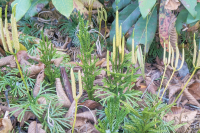Draft red wolf plan released
 Red wolf. USFWS photo
Red wolf. USFWS photo
The U.S. Fish and Wildlife Service has released a draft version of a plan to guide recovery of the critically endangered red wolf, with a virtual public meeting to offer an update on the Red Wolf Recovery Program 6 to 8 p.m. Wednesday, Oct. 5.
The new plan would replace the original recovery plan approved in 1982, with revisions in 1984 and 1991. Red wolves once inhabited a vast region stretching from southern New York to central Texas, including the entire Southeast, but by the 1970s the species was nearly extinct due to human persecution and habitat loss. It was placed on the endangered species list in 1973, the same year the USFWS began developing a captive breeding program to allow future reintroductions into the wild.
Currently, the world’s only wild red wolves exist in a five-county area of eastern North Carolina, but their presence and management there has proven contentious, with environmental groups launching a succession of legal battles against management decisions by the USFWS and N.C. Wildlife Resources Commission that they claimed undermined the species’ ability to survive. As of June 2022, only an estimated 19-21 red wolves remained.
The USFWS says that the draft recovery plan will help reverse this trend, providing measurable and objective criteria against which progress toward the species’ recovery can be tracked. The plan includes actions to improve the red wolf population’s resilience, redundancy and representation and establishes goals for adequate numbers, habitat and genetic diversity, along with multiple resilient populations within the red wolf’s historic range. The plan also prioritizes collaborative conservation to engage stakeholders in management efforts and therefore mitigate threats to the red wolf population, the USFWS said.
“This plan underscores the Service’s commitment to working with others to conserve the red wolf – one of the most endangered canids in the world – and finding solutions that address the needs of the species and surrounding communities,” said Service Director Martha Williams. “Successful recovery will require collaborative efforts with all who are involved and interested in red wolf recovery. These efforts will include direct and transparent engagement with our partners, landowners and other stakeholders to facilitate a coexistence between people and red wolves.”
The ultimate goal, the USFWS said, is to recover the species to the point that Endangered Species Act protections are no longer needed.
Recovery plans are non-regulatory documents that provide guidance on how best to recover a species. This plan was drafted by the Red Wolf Recovery Team, a collaborative partnership of federal and state agencies, tribal representatives, county government, academia, zoos/conservation centers, non-profit organizations, non-governmental organizations and landowners.
Comments on the draft plan will be accepted through Oct. 28, with a final revised plan to be posted by the court-ordered date of Feb. 28, 2023. Email comments to This email address is being protected from spambots. You need JavaScript enabled to view it. with “Comment on Draft Recovery Plan” in the subject line.
To register for the virtual public meeting and submit questions for the question-and-answer portion of the agenda, or to view the draft recovery plan, visit fws.gov/project/red-wolf-recovery-program.









